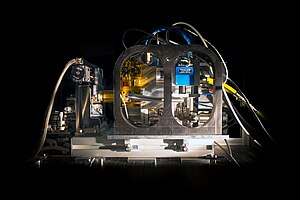
Back Detector d'infrarojos Catalan Detector de infrarrojos Spanish آشکارساز فروسرخ Persian Détecteur infrarouge French Rivelatore ad infrarossi Italian 적외선 검출기 Korean Infraroodsensor Dutch Detektor podczerwieni Polish Detector infravermelho Portuguese அகச் சிவப்பு அலை கண்டறிவான் Tamil
This article needs additional citations for verification. (June 2012) |

An infrared detector is a detector that reacts to infrared (IR) radiation. The two main types of detectors are thermal and photonic (photodetectors).
The thermal effects of the incident IR radiation can be followed through many temperature dependent phenomena.[2] Bolometers and microbolometers are based on changes in resistance. Thermocouples and thermopiles use the thermoelectric effect. Golay cells follow thermal expansion. In IR spectrometers the pyroelectric detectors are the most widespread.
The response time and sensitivity of photonic detectors can be much higher, but usually these have to be cooled to cut thermal noise. The materials in these are semiconductors with narrow band gaps. Incident IR photons can cause electronic excitations. In photoconductive detectors, the resistivity of the detector element is monitored. Photovoltaic detectors contain a p-n junction on which photoelectric current appears upon illumination.
An infrared detector is hybridized by connecting it to a readout integrated circuit with indium bumps. This hybrid is known as a focal plane array.
- ^ "Revolutionary New High-speed Infrared Detector Sees First Light". Retrieved 15 June 2015.
- ^ Avraham, M.; Nemirovsky, J.; Blank, T.; Golan, G.; Nemirovsky, Y. (2022). "Toward an Accurate IR Remote Sensing of Body Temperature Radiometer Based on a Novel IR Sensing System Dubbed Digital TMOS". Micromachines. 13 (5): 703. doi:10.3390/mi13050703. PMC 9145132. PMID 35630174.